I've been dragging my feet writing this how to homeschool guide for weeks. Months! Over a year, if I'm being honest. Our family's journey to homeschooling has been up and down, forward and backward, and somehow fast and slow-feeling all at once.
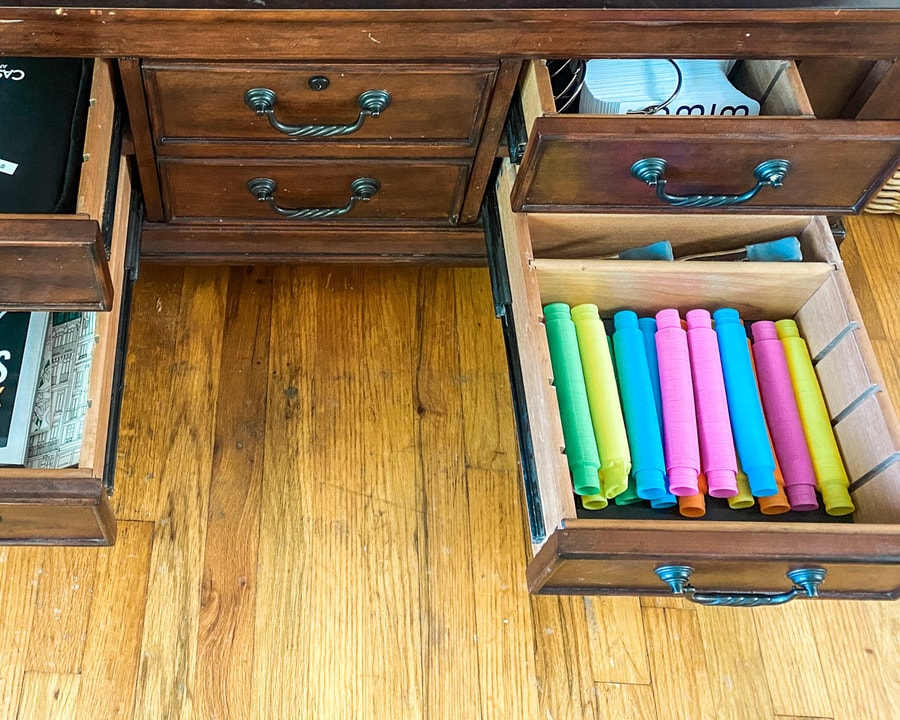
Now that we're well over a year into homeschooling, I can tell you that I wouldn't have it any other way. In our family's case, we're homeschooling multiple ages at once. That comes with unique challenges and joys, and it's SO MUCH FUN!
Why ME as your Homeschooling Guide?
I'm a former 3rd grade teacher with experience in both public and private schools. I left the field to pursue marketing when I started my own family. That said, I've always been extremely passionate about childhood education. My studies at UCLA included a strong focus on both psychology and the politics behind brick-and-mortar, charter schools and alternate teaching methodologies.
I started part-time homeschooling my now-9-year-old in 1st grade, and my husband and I currently full-time homeschool him as well as his 7, 5, and 3-year-old brothers.
Even with all that background, I initially struggled when friends, readers and loved ones reached out asking for homeschooling help. Here's the truth: I NEVER wanted to homeschool. I really, truly enjoy my free time. The only reason we started homeschooling was because our oldest son has learning differences. We've had an IEP in place for him since he was 3, but his needs were never properly handled in a traditional setting.
After countless meetings with district heads, principals and teachers and seemingly-endless hours of therapy sessions and intervention, our son was frustrated. Nate and I were pulling our hair out, spread thin, exhausted by too many outsiders trying to weigh in on what was best for us. Our family decided enough was enough. We would leave the traditional elementary school setting for good.
Is Homeschooling Right for my Family?
When the current world situation started taking form, I received hundreds of messages from people who seemed to be in a very similar situation to where we found ourselves when we were figuring out how to homeschool. They don't feel that traditional school buildings are safe for children in this environment. In many instances, the “distance schooling” solution is requiring entire family schedules be dictated by one child's computer access from 8am-3pm. This simply doesn't feel tenable for parents who find themselves juggling work, more than one child, and other personal factors.
So here we find ourselves, collectively, left with one option: reluctantly figuring out how to homeschool. I want to tell you, dear reader, that I GET IT. This is not what you want for your children. This has never been your dream. You worry about socialization and mental health. Frankly, there's this quiet screeching fear in the back of your mind that you'll drop the ball and wind up with a kid who's a total dummy.
Breathe.
Let me say that again. Breathe. Give yourself permission to recognize that welling panic, and work through it in a logical manner. The good news is that we're all in this together. There are thousands of people feeling how you do right now. And there are TONS of incredible reasons to homeschool and upsides that you'll see, with time. I promise. Grieve the loss of your plans. Assess the options in front of you. And move forward.
Start Homeschooling Correctly
The first step is to investigate your state homeschool laws. The Homeschool Legal Defense Association has a clear, concise guide that will walk you through the steps for each state. Our family actually chose to move to Idaho in large part due to their low regulations for homeschooling.
You'll also want to look into state homeschool funds that may help guide your efforts and ease your costs. Various states have rules, oversight, reporting, testing requirements and legal hoops to jump through for this, and you'll never have QUITE as much freedom when you take state funds as you will if you don't. That said, we have personally taken part in these charter programs with California and are now with one in Idaho that we absolutely love. In our experience, these programs provide an awesome network of supportive fellow parents and experienced teachers who can help you out.
Finally, it's time to plan and organize your own homeschool routine.
Our Homeschool Schedule
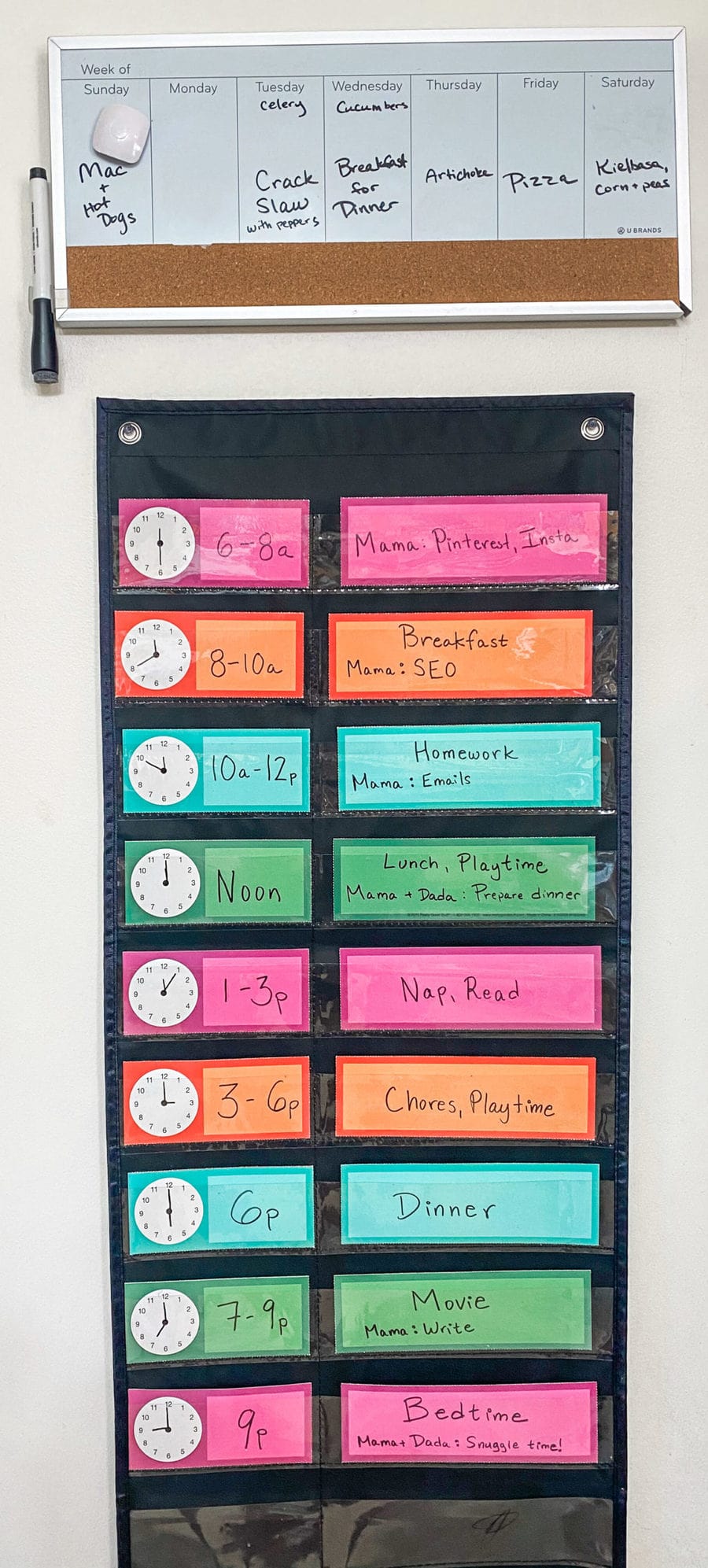
This is what 99% of parents ask us when they reach out about homeschooling. “What does your homeschool schedule look like?”
Oh man. Hold onto your hats, this is gonna be a doozy.
We have a rough schedule for each day, and “formal homeschooling” is a very minimal part of it. This chart was sent to us from Really Good Stuff (I love them!) and it's really good because we can switch it up based on season or personal desire or whims. You'll notice that homeschool is a brief portion of the day, in the morning, which our family simply refers to as “homework.” In fact, most of our day is free play, chores, and reading. I also outline my own tasks on here so the kids can develop an understanding of what my job looks like, and develop a respect for my time and effort when I'm working.
Why such a short period allotted to homeschool? Here's the thing: children are always learning. Homeschooling does not and should not look like a traditional school day.
I'll repeat that for emphasis, because it's going to take a lot of self-discipline for most of you guys to resist the urge to divide your life into rigid, mini-school-like sessions. HOMESCHOOL DOES NOT LOOK LIKE SCHOOL. If you try to break your child's day into 2-hour chunks dedicated to math, science, English, foreign languages, history, social studies, physical education, art, music, technology and computer lessons…your family will burn out fast. Multiple studies have shown that homeschool families who take this approach wind up getting frustrated and quitting within a year.
Instead, start with a period of unschooling. Give your child a complete break to unlearn habits and feelings (often negative ones) associated with the classroom. They need to unlearn hall passes, punishments, star charts, and scheduled intervals. They need to learn how to follow their own passions and interests. Listen to your children when they tell you what they're interested in.
What is Unschooling?
Unschooling is allowing your child to pursue life and knowledge on their own terms. It is NOT rejecting education altogether. It is NOT letting your kid sit around playing Nintendo for hours on end. It is following their lead and supporting their natural learning instincts.
I'll give you an example.
When we first started homeschooling, our oldest son was nearly a year behind in reading – after spending tons of time on the district-provided busy work. My kid loudly declared that these workbooks were “soooo boring!” I decided to take a step back and approach things HIS way. I asked what he actually wanted to read. His answer? Comic books! So I sought out comic books for little kids, starting with ones that had simplistic, nonsensical words for him to sound out. We went from little sounds like “BLIP!” in Barnaby Richards' TOON series to actual words in Elephant and Piggie, on to Dog Man and eventually full sentences and logical storylines in Calvin & Hobbes.
My child moved up two grade levels – all in bubble format – simply because that's what made him want to do the work.
Unschooling gives your child space to fall in love with learning all over again.
Homeschool Guide
Now most of you are sitting there like, “Okay, but seriously, Chelsea, I'm gonna need SOME sort of homeschool guide to help me through this.” Fine, if you insist, I'll put on my teacher hat.
Most educational institutions roughly follow the Core Knowledge Sequence. The “What your __ Grader Needs to Know” Core Knowledge Series books are an excellent guide to staying on-track with public school lessons. I don't follow these resources to the letter, but I do find security in knowing that my kids are roughly on-track with their peers and there won't be any major gaps in their knowledge whenever I send them back out into the world. The books can be a little dense overall, so here's a mini-breakdown of the highlights I try to hit in each grade:
| Language Arts | Math | Science | Social Studies | |
| K | ☐ Retell a story and/or present information ☐ Understand stories vs poems ☐ Listen to non-fiction ☐ Recognize and practice printing letters ☐ Know letter sounds | ☐ Count items ☐ Write numbers ☐ Count and compare numbers ☐ Add and subtract 1-10 ☐ Measure bigger and smaller ☐ Shapes | ☐ Object movement ☐ Sunlight and shade ☐ Plants ☐ Animals and habitats ☐ Non-living things ☐ Weather ☐ Seasons | ☐ Family differences and traditions around the world ☐ Maps and globes ☐ Economic needs and wants ☐ Rules and why we need them ☐ Personalities and moods ☐ Community helpers ☐ US flag ☐ Holidays |
| 1st | ☐ Present information ☐ Write a sentence with a capital and period ☐ Explain non-fiction vs fiction ☐ Recognize phonics and words ☐ Write a letter to a friend (spelling doesn't matter) ☐ Share a new word they learned ☐ Practice handwriting | ☐ Place value ☐ Add and subtract within 20 ☐ Understand operations (+, -, =) ☐ Sorting ☐ Measure length ☐ Relationship between addition and subtraction (know that 3+2=5 and 5-3=2) ☐ Graphs, Shapes ☐ Tell time ☐ Find 10 more and 10 less than any given number under 100 ☐ Word problems | ☐ Communicating sound over distance ☐ Darkness and light ☐ Day and night ☐ Life cycles ☐ Solutions in nature (ex horse hooves are similar to shoes that people use) ☐ Parents and offspring basic genetics ☐ Solar system | ☐ Environmental adaptation ☐ Problem solving and decision making ☐ US symbols ☐ Pledge of Allegiance ☐ Holidays ☐ Economic needs and solutions ☐ Family structure around the world ☐ Maps and globes ☐ Coins and ways to save money ☐ Home responsibilities ☐ Family history ☐ Economic institutions |
| 2nd | ☐ Retell a story ☐ Share information from a non-fiction source ☐ Recognize phonics and early spelling ☐ Read out loud ☐ Write a letter to a friend (check spelling and correct simple words) ☐ Create a written or audio report about something they learned ☐ Share a new word they learned ☐ Practice handwriting | ☐ Word problems with addition and subtraction ☐ Add and subtract within 20 ☐ Start skip counting (3+3+3=9 or 5+5+5=15) ☐ Understand place value with larger numbers (700+30+2=732) ☐ Mentally add or subtract 10 ☐ Estimate length ☐ Add and subtract length ☐ Tell time ☐ Understand coins and bills ☐ Create graphs ☐ Basic fractions | ☐ Hard vs soft materials ☐ Changing states (heating and cooling water) ☐ Plants need sunlight and water ☐ Circle of life between plants and animals ☐ Change on Earth over time ☐ Draw a map (real or imaginary) | ☐ Culture and community groups ☐ Landmarks and symbols on maps and globes ☐ Environmental factors on our lives ☐ Goods vs services and producers vs consumers ☐ How natural resources impact economy ☐ Personal finance ☐ Governmental rules and enforcement |
| 3rd | ☐ Summarize chapters from a book ☐ Give a report on non-fiction learnings ☐ Understand prefixes and suffixes ☐ Blend words reliably ☐ Write and edit own work ☐ Understand word tenses and types of sentences ☐ Increase vocabulary | ☐ Multiplication ☐ Early division within 100 ☐ Fractions ☐ Volume and mass ☐ Create graphs and draw conclusions based on them ☐ Area ☐ Perimeter ☐ Divide shapes into fractions | ☐ Force and motion on an object ☐ Patterns in motion ☐ Magnetic forces ☐ Animal interactions ☐ Heredity ☐ Environmental influences on animals ☐ Severe weather solutions (barriers to flooding, etc) ☐ Climate | ☐ How communities and groups influence daily lives ☐ Role of migration and immigration ☐ American Indian culture ☐ Organization of Earth on a globe (identify our state, major waterways and continents) ☐ Public vs private property ☐ Bank roles ☐ How laws are made ☐ Local government functions ☐ Global connections around the world |
| 4th | ☐ Summarize chapters from a book ☐ Give a report on non-fiction learnings ☐ Understand prefixes and suffixes ☐ Blend words reliably ☐ Write and edit own work ☐ Understand word tenses and types of sentences ☐ Increase vocabulary | ☐ Solve problems using the four operations ☐ Factors and multiples ☐ Complicated patterns ☐ Multi-digit arithmetic ☐ Compare fractions and equivalents ☐ Multiply and add and subtract fractions ☐ Introduce decimals ☐ Measurement conversions ☐ Interpret graphs ☐ Angles ☐ Complicated shapes | ☐ Speed and energy ☐ Transfer of energy ☐ Energy change ☐ Energy waves ☐ Light ☐ Rocks and fossils ☐ Erosion and weathering ☐ Energy resources ☐ Solutions to natural disasters | ☐ Influence on local cultures ☐ Immigration patterns and historical roles ☐ Indian tribes and early economies/bartering ☐ Technological innovations' impact on economy ☐ Business and entrepreneurship ☐ Law enforcement through the courts ☐ State official election ☐ Democracy and civil liberties through history ☐ US states |
| 5th | ☐ Explain fiction vs non-fiction ☐ Understand point of view ☐ Give a detailed report on something personally researched ☐ Explore the dictionary and thesaurus | ☐ Math problems with parentheses ☐ PEMDAS ☐ Operations with multi-digit numbers ☐ Decimals to hundredths ☐ Add and subtract more complicated fractions ☐ Multiply and divide fractions ☐ Convert measurement units ☐ Volume ☐ Graph points on a plane ☐ Classify shapes | ☐ Atoms and matter ☐ Mineral identification ☐ Compounds and mixtures ☐ Gravity ☐ Energy cycle ☐ Plant growth ☐ Fossils ☐ Natural selection ☐ Ecosystems ☐ Climate change ☐ Constellations ☐ Water on Earth ☐ Conservation of Resources | ☐ European impact on US founding ☐ Western expansion ☐ Latitude/longitude ☐ US state capitals and territories ☐ Economic markets ☐ Taxation and tariffs ☐ US Constitution and Bill of Rights ☐ Three branches of government ☐ President and state representatives ☐ Republicans and Democrats ☐ Varying nation governments |
| 6th | ☐ Writing process ☐ Essays | ☐ Ratios ☐ Divide fractions by fractions ☐ Common factors ☐ Positive and negative numbers ☐ Algebraic expressions ☐ Single variable equations ☐ Dependent and independent variables ☐ Surface area ☐ Statistical variability ☐ Distributions | ☐ Molecules ☐ Chemical reactions ☐ Synthetic materials ☐ Thermal energy ☐ Newton's laws of motion ☐ Kinetic energy and mass ☐ Behavior of waves | ☐ Civilizations of Western Hemisphere prior to European contact ☐ Compare map projections ☐ Earth/sun relationships ☐ Rural vs urban populations ☐ Abundance vs scarcity ☐ Governments in the Western Hemisphere |
| 7th | ☐ Writing process ☐ Similes and metaphors ☐ Prepositional phrases ☐ Clauses | ☐ Ratios and proportional relationships ☐ Rational numbers ☐ Equivalent expressions ☐ Complicated word problems ☐ Geometrical figures ☐ Angles and area ☐ Drawing inferences with random sampling ☐ Probability | ☐ Parts and functions of cells ☐ Body systems ☐ Photosynthesis ☐ Symbiosis ☐ Genetic mutations ☐ Asexual and sexual reproduction ☐ Human evolution ☐ Population growth | ☐ Cultures of Eastern Hemisphere prior to European contact ☐ How to use maps ☐ Human impact on climate ☐ Current characteristics and issues of countries in the Eastern Hemisphere ☐ Governments in the Eastern Hemisphere |
| 8th | ☐ Showing vs telling | ☐ Radicals and integer exponents ☐ Lines and linear equations ☐ Function relationships ☐ Geometry ☐ Pythagorean Theorum ☐ Volume of cylinders and cones and spheres ☐ Bivariate data | ☐ Moon phases and eclipses ☐ Geologic time ☐ Rock cycle ☐ Earth's changing surface ☐ Tectonic plate motion ☐ Water cycle ☐ Weather forecasting ☐ Ocean's impact on earth's climate ☐ Carbon and fossil fuels ☐ Natural hazards ☐ Human environmental impact ☐ Climate change | ☐ Rise of human civilization ☐ Ancient technological advances ☐ How culture evolved over time ☐ Role of religion ☐ Chart courses on maps ☐ Impact of waterways on civilization ☐ Evolution of economics ☐ Evolution of democracy and global expansion ☐ Major conflicts of the 20th century |
Beyond 8th grade is specialized and we aren't there yet, but your state should provide tons of options for online learning, pursuit of personal interests, vocational studies and more.
Homeschool Curriculum
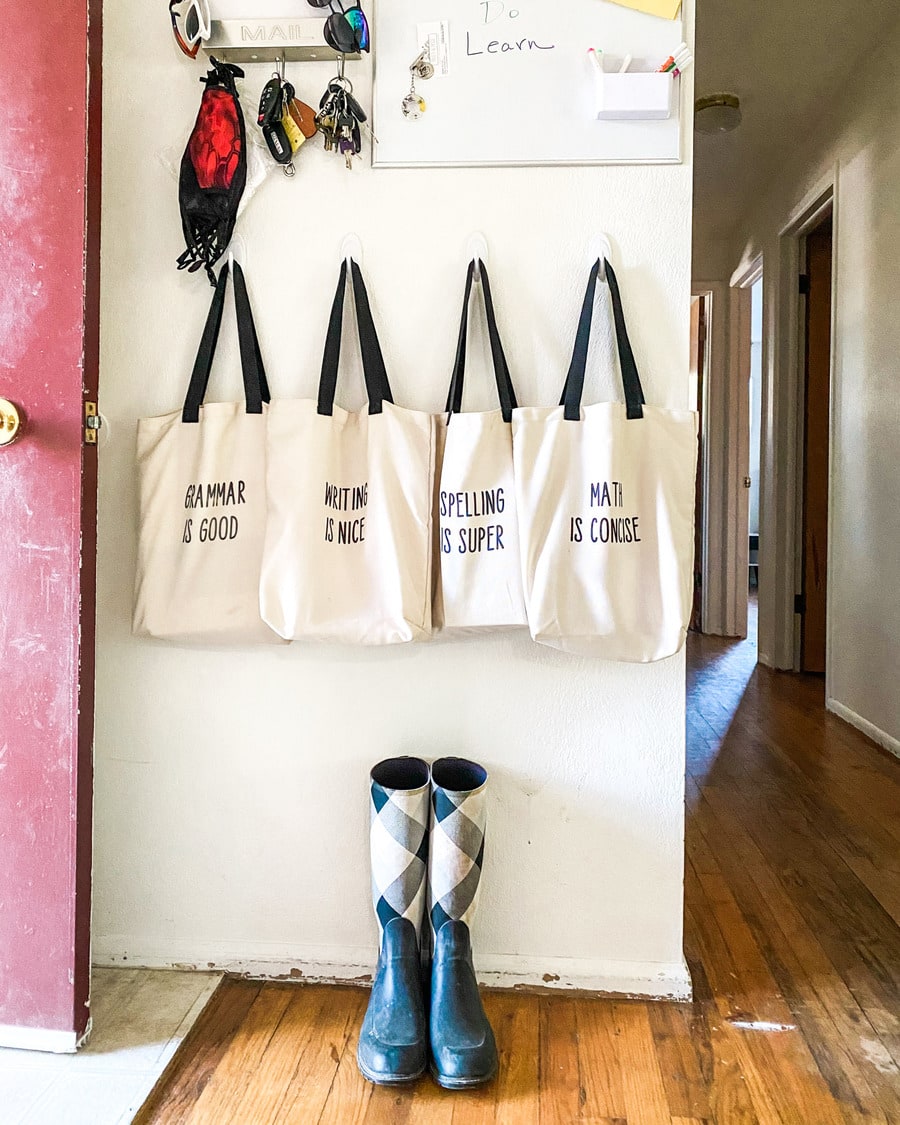
First and foremost, I prefer to formally focus on two subjects: language arts and math. If your child can properly read, write and compute numbers, they'll get along in the world. That IS important. The rest is gravy. So here's what our curriculum looks like:
- Homeschool Math: Life of Fred for 1st grade and up. These are engaging, story-based, complete curriculum books that build upon the knowledge from the last book and can EASILY be used with multiple grades sharing the same book. They're the perfect solution for big families wanting to tackle math together! Mega-bonus: kids who read independently with good comprehension can do this curriculum almost entirely on their own, with very little parent guidance. I start 1st-4th graders on Apples, and 5th graders or older on Edgewood. It may be review for some, but they're entertaining enough that kids who already understand the math concepts being discussed can burn through them quickly. You can search Teachers Pay Teachers for worksheets to print out for the kids to do the practice at the end of each chapter. Under 1st grade, I simply do hands-on math and free worksheets for early number practice.
- Homeschool English: These are the only subjects that we have a parent lead directly. We do Fix It Grammar and All About Spelling with 2nd grade and higher (these are also both perfect for teaching multiple grades at once). Those two together take about half an hour each day, four days per week (if that's too hands-on for you – which is sometimes it for us when life gets nuts, try Teacher File Box for easy, printable, open-and-go lessons). On top of that, I have my kids ages kindergarten and up do Handwriting without Tears and then we all do lots of free writing prompts and journaling about our day. My First Story Writing Book is a fantastic way to get elementary kids into creative writing. With kindergarteners, we primarily focus on letter recognition and learning to read with Teach Your Child to Read in 100 Easy Lessons and Bob Books, coupled with Reading Eggs and random worksheets from Teachers Pay Teachers.
- Homeschool Science: We subscribe to ALL the streaming services and devour as many scientific videos as humanly possible. We watch One Strange Rock on National Geographic/Disney+ and I have the older kids answer basic questions about what they watched, just to check for comprehension and keep them on-task. Cosmos is another favorite. They also love Bill Nye, which we purchase directly on Amazon Prime or Vudu. Magic School Bus on Netflix rocks, too! We also recently discovered Kurzgesagt and are OBSESSED. And for more hands-on fun, we do a lot of experiments that we find on blogs, Pinterest, and the occasional MEL Science kit. We also do fun stuff like owl pellet dissection, raising butterflies and gardening.
- Homeschool Social Studies: Basically the same as science. Before the world situation came into play, we visited a LOT of museums. Now, the kids all watch episodes of Super Why! and fill out worksheets that I create for them (I'll get those published here ASAP). Beyond that, we enjoy unit studies that basically just follow the kids' lead. We've done reports on our family heritage, civil rights studies including watching Ruby Bridges and reading related books, and lots of library visits prompted by Timelines of Ancient Civilizations on Amazon. We tried doing Story of the World which is an EXCELLENT curriculum, but I've found that the kids engage better when we follow their interests. At this point, I'm comfortable enough doing searches based on the rough grade-level guidelines above and going down the internet rabbit hole to find unit-based activities that will engage the kids in each topic.
Homeschool Organization
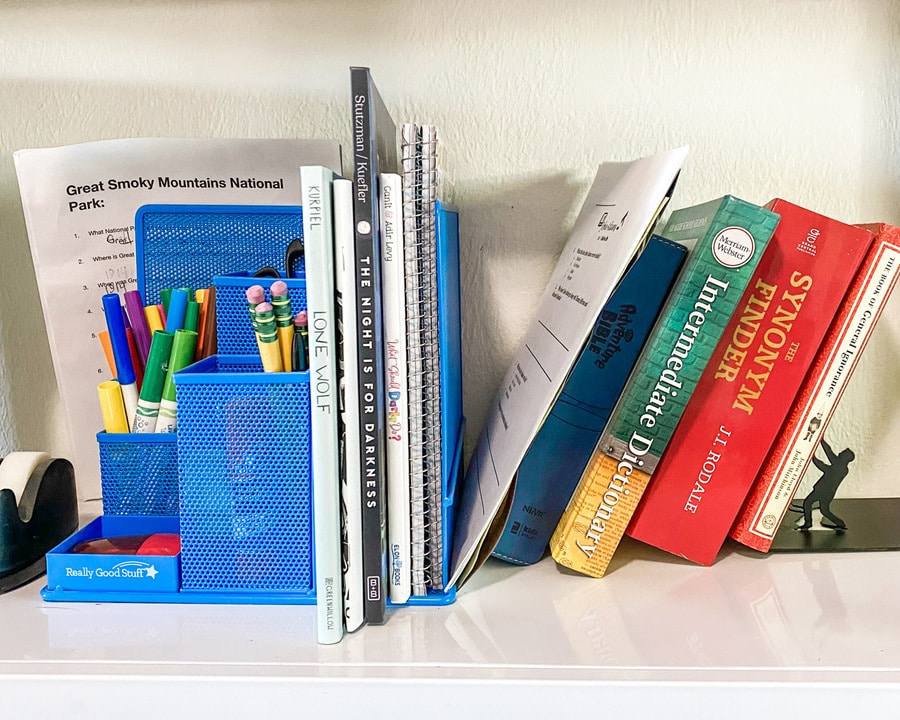
This is going to require a WHOLE post devoted to it. Basically, I stash the kids' workbooks in tote bags that I made with the Cricut Joy. I really, really love that the majority of the boys' most important work is done offline, with minimal busy work. Since we rely heavily on movies and streaming shows for history and science, it was important to me that math and english topics be non-screen-based as much as possible.
The majority of work is done at our kitchen table. Since it only takes a couple hours a day, we squeeze it right in between breakfast and lunch and have things stashed back in their places before my extreme compulsion to clear off that dang table for dinner kicks in! The boys have a little stand on a nearby shelving unit for pencils, notebooks, tape, etc. It has a slot for new books to read, a space for blank science/history worksheets, and a slot to put completed worksheets. This stand is also from Really Good Stuff. Easy peasy.
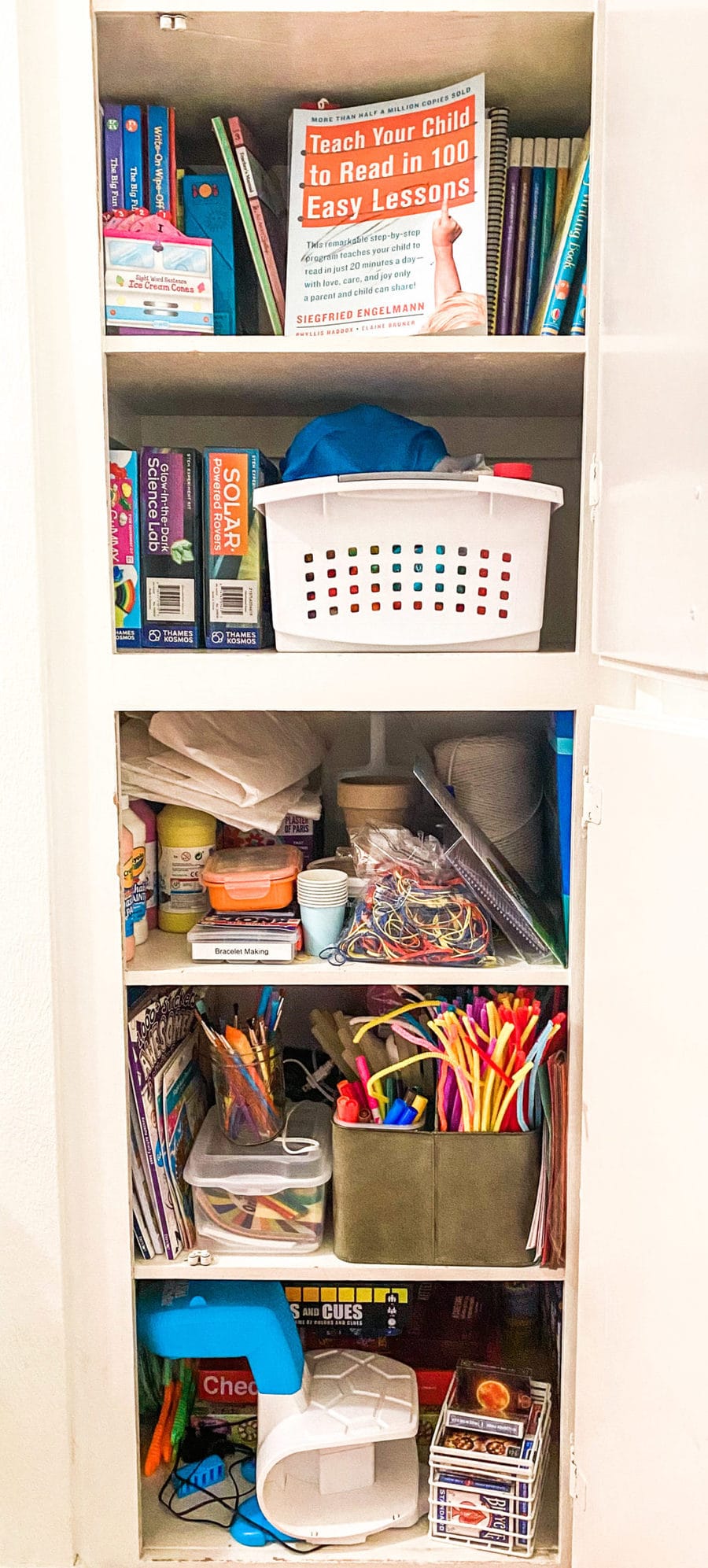
Then, there's what we call the “boredom closet.” Not sure what to do with yourself? Check out the boredom closet! Top to bottom it’s: workbooks, hands-on projects / capes / bubbles / Wikistix / outdoors stuff, crafts, more crafts, and games. This requires another dedicated post, but for keeping the kids entertained I LOVE standard Bicycle cards, Thames and Cosmos kits, Creatto kits, a Smart Sketcher, Perler beads, plus all of our go-to kids craft essentials.
We also keep our Gift Ideas for Families post updated with the latest-and-greatest that we discover every holiday season.
Homeschool Socialization
This is a tough one. Before we all got stuck at home, we made sure the kids got a chance to engage with other children their own age at clubs, YMCA classes, the bounce house and other in-person activities. Now, we rely mostly on online resources such as the (awesome!) STEM camp they're currently taking part in. We're also fortunate to be utterly surrounded by young families in our neighborhood. The boys can just pull a ladder up to the back fence and holler anytime they feel compelled to converse with someone their age OTHER than their own siblings.
This is the beauty of getting involved with a local/regional/district charter or other homeschool group. There is always someone more than thrilled to hop on Facebook Messenger or Zoom and chat through your interests. This includes parents, too. I've never felt more supported than I have by complete strangers whom I've connected with in the homeschool world.
Beyond establishing a community, I think that it is absolutely crucial to discuss emotions and mental wellbeing with kids. We like to flip through Connection Zoo cards over dinner. They feature zoo animals and their characteristics and strengths. Your kids can have concrete examples of adaptable animals so that in stressful situations, they can remember to “find a trusted team member” like zebras do, or “take a hissing breath” like a milk snake to calm themselves. They can even gamify it, with zookeeper badges and rewards and stickers galore!
I Will Help You Learn How to Homeschool
That brings me to my final conclusion (and WOW, I'm in awe and amazed that you made it nearly 3000 words into this epic brain dump of mine). After going through our own family struggles trying to establish a routine that involved homeschool in a way I was comfortable with, I am deeply passionate about supporting other families in learning how to homeschool. I will be using my weekly email newsletters to offer ideas on things that families can make, do and learn together each week. I'll also be uploading lots of curriculum ideas and self-made worksheets that I use with my own kids in accompaniment with streaming shows! If you're not sure how to cover science or history, or need some inspiration for hands-on ideas, you'll find tons of that here.
I know all too well that sinking feeling when you look around and feel like the dreams you had for your child's future – and your own – are falling apart. I promise that there is beauty and grace in accepting the current reality and making the best of it. It sounds trite now, but I can tell you that my own family has grown in leaps and bounds from the de-construction of our expectations. If you lean into this time, it can strengthen your children and transform your family in ways you may not currently think possible.
I'll be here, sharing real-time examples of what our family is doing. And I'll be here, in person, ready to respond to your questions and offer up supportive words directly.
I'm excited for you to learn how to homeschool, just like we did! Trust me, if we can do it, you can, too!